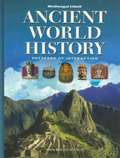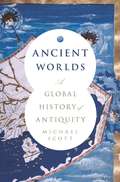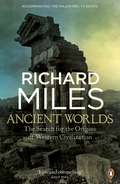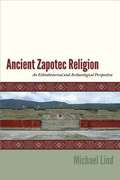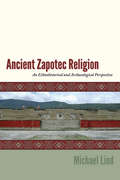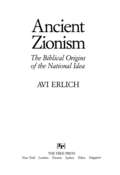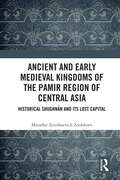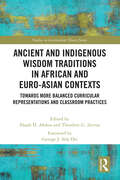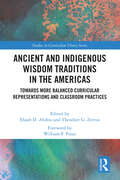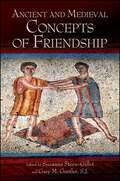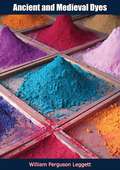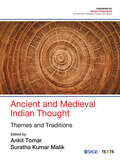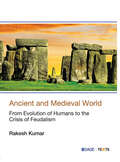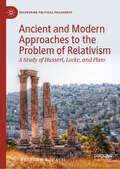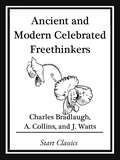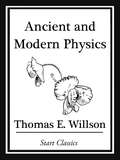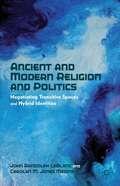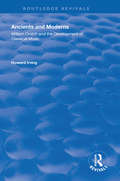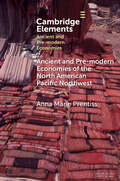- Table View
- List View
Ancient World History: Patterns of Interaction
by McDougal LittellThe text in the 'Ancient World History: Patterns of Interaction' covers topics on: Beginnings of Civilization; New Directions in Government and Society; An Age of Exchange and Encounter; Connecting Hemispheres; and Absolutism to Revolution.
Ancient World: Adventures in Time and Place
by James A. Banks Walter C. Parker Gloria Ladson-Billings Barry K. Beyer Gloria Contreras Jean Craven Mary A. McFarlandAncient World: Adventures in Time and Place has 15 chapters, each with two or more lessons. There are also many special features for you to study and enjoy. The unit lessons cover: Understanding the Ancient World, Dawn of Civilization, Mesopotamia and Africa, India, China, and the Americas, Ancient Israel and Greece, and Rome.
Ancient World: Adventures in Time and Place
by The Editors at Mc Graw HillCalifornia proofread textbook for sixth grade. Investigates the history of the ancient world.
Ancient Worlds (DK Panorama)
by DKAncient Worlds is a tour through history's most influential civilizations between 3000 BCE and 600 CE, capturing in vivid detail moments that convey the cultural, technological, and organizational characteristics central to their success.From Sumer, the world's earliest civilization, to the heyday of the Mayan Empire, the tour crosses every continent, taking in developments in urban planning, art and architecture, religion, warfare, trade, and cultural exchange. Discover how deep knowledge of the Sun, sea, and stars enabled ancient seafarers to navigate the Pacific Ocean; witness the highs and lows of a thrilling chariot race in the Roman Empire's greatest hippodrome; and marvel at the military might of the Mauryan Empire and its 9,000 war elephants. Full of fascinating detail, each scene is a window on the lives of the most powerful and innovative peoples in times past. Ideal for children and parents to pore over together and explore similarities and differences with cultures around the world today.
Ancient Worlds: A Global History of Antiquity (Key Themes In Ancient History Ser.)
by Michael Scott"As panoramic as it is learned, this is ancient history for our globalized world."Tom Holland, author of Dynasty and RubiconTwenty-five-hundred years ago, civilizations around the world entered a revolutionary new era that overturned old order and laid the foundation for our world today. In the face of massive social changes across three continents, radical new forms of government emerged; mighty wars were fought over trade, religion, and ideology; and new faiths were ruthlessly employed to unify vast empires. The histories of Rome and China, Greece and India-the stories of Constantine and Confucius, Qin Shi Huangdi and Hannibal-are here revealed to be interconnected incidents in the midst of a greater drama.In Ancient Worlds, historian Michael Scott presents a gripping narrative of this unique age in human civilization, showing how diverse societies responded to similar pressures and how they influenced one another: through conquest and conversion, through trade in people, goods, and ideas. An ambitious reinvention of our grandest histories, Ancient Worlds reveals new truths about our common human heritage."A bold and imaginative page-turner that challenges ideas about the world of antiquity."Peter Frankopan, author of The Silk Roads
Ancient Worlds: The Search for the Origins of Western Civilization
by Richard MilesAcross the Middle East, the Mediterranean and the Nile Delta, awe-inspiring, monstrous ruins are scattered across the landscape - vast palaces, temples, fortresses, shattered statues of ancient gods, carvings praising the eternal power of long-forgotten dynasties. These ruins - the remainder of thousands of years of human civilization - are both inspirational in their grandeur, and terrible in that their once teeming centres of population were all ultimately destroyed and abandoned.In this major book, Richard Miles recreates these extraordinary cities, ranging from the Euphrates to the Roman Empire, to understand the roots of human civilization. His challenge is to make us understand that the cities which define culture, religion and economic success and which are humanity's greatest invention, have always had a cruel edge to them, building systems that have provided both amazing opportunities and back-breaking hardship.This exhilarating book is both a pleasure to read and a challenge to us all to think about our past - and about the present.
Ancient Wyoming: A Dozen Lost Worlds Based on the Geology of the Bighorn Basin
by Kirk Johnson Will ClydeSponsored by a grant from the National Science Foundation to the Denver Museum of Natural History. Ever wondered what the ground below you was like millions of years ago? Merging paleontology, geology, and artistry, Ancient Wyoming illustrates scenes from the distant past and provides fascinating details on the flora and fauna of the past 300 million years. The book provides a unique look at Wyoming, both as it is today and as it was throughout ancient history—at times a vast ocean, a lush rain forest, and a mountain prairie.
Ancient Zapotec Religion
by Michael LindAncient Zapotec Religion is the first comprehensive study of Zapotec religion as it existed in the southern Mexican state of Oaxaca on the eve of the Spanish Conquest. Author Michael Lind brings a new perspective, focusing not on underlying theological principles but on the material and spatial expressions of religious practice.Using sixteenth- and seventeenth-century Spanish colonial documents and archaeological findings related to the time period leading up to the Spanish Conquest, he presents new information on deities, ancestor worship and sacred bundles, the Zapotec cosmos, the priesthood, religious ceremonies and rituals, the nature of temples, the distinctive features of the sacred and solar calendars, and the religious significance of the murals of Mitla--the most sacred and holy center. He also shows how Zapotec religion served to integrate Zapotec city-state structure throughout the valley of Oaxaca, neighboring mountain regions, and the Isthmus of Tehuantepec.Ancient Zapotec Religion is the first in-depth and interdisciplinary book on the Zapotecs and their religious practices and will be of great interest to archaeologists, epigraphers, historians, and specialists in Native American, Latin American, and religious studies.
Ancient Zapotec Religion: An Ethnohistorical and Archaeological Perspective
by Michael LindAncient Zapotec Religion is the first comprehensive study of Zapotec religion as it existed in the southern Mexican state of Oaxaca on the eve of the Spanish Conquest. Author Michael Lind brings a new perspective, focusing not on underlying theological principles but on the material and spatial expressions of religious practice. Using sixteenth- and seventeenth-century Spanish colonial documents and archaeological findings related to the time period leading up to the Spanish Conquest, he presents new information on deities, ancestor worship and sacred bundles, the Zapotec cosmos, the priesthood, religious ceremonies and rituals, the nature of temples, the distinctive features of the sacred and solar calendars, and the religious significance of the murals of Mitla—the most sacred and holy center. He also shows how Zapotec religion served to integrate Zapotec city-state structure throughout the valley of Oaxaca, neighboring mountain regions, and the Isthmus of Tehuantepec. Ancient Zapotec Religion is the first in-depth and interdisciplinary book on the Zapotecs and their religious practices and will be of great interest to archaeologists, epigraphers, historians, and specialists in Native American, Latin American, and religious studies.
Ancient Zionism: The Biblical Origins of the National Idea
by Avi ErlichThe ancient Hebrews, Erlich argues, invented a unique basis for social unity by forging an imaginative link between religion (or law), literary culture, and the specific land of Israel. In this conception, the land, the law, and the people of Israel are one, a living metaphor expressed in the idea of Zion. The unity of land, law, and literature created by the Hebrews has been one of the most potent historical metaphors ever devised, strong enough to maintain a sense of national identity among Jews for over two thousand years. Without this Jewish literary culture, Erlich argues, there could have been no state of Israel, no matter what efforts were made by modern Zionist ideologues. This book reads the ancient text with ancient eyes that make it startling and fresh for those conditioned to the "modern" view of national identity as based on either race or ideology. Modern Zionism, like modern nationalism generally, is a drastically impoverished descendant of this original Jewish nationalism, and Erlich concludes that many problems not only of Israel but of all modern nations struggling to define themselves in a changing world really stem from the loss of this vigorous ancient alternative.
Ancient and Early Medieval Kingdoms of the Pamir Region of Central Asia: Historical Shughnān and its Lost Capital
by Muzaffar Zoirshoevich ZoolshoevThis focused study is one of the few analytical resources in English that covers the ancient and early medieval history of one of the least studied areas of the vast mountainous Pamir region of Central Asia: Shughnān. The book brings together scattered fragments of information from a wide range of early Greek, Chinese, Persian, and Arabic sources, the accounts of early European travellers and the scholarly contributions of Soviet and post-Soviet authors, as well as personal accounts and oral history material from the region. Drawing on historical, archaeological, linguistic, and ethnographic data, it provides a holistic overview of the kingdom of Shughnān. It also attempts, for the first time, to identify and locate the town of Kǔhán, which the Chinese historical chronicle, the Táng Shū (Book of the Tang Dynasty, 618–907 CE) describes as the ‘first capital’ of Shughnān. Many archaeological sites are examined and offered as potential candidates for the location of the town of Kǔhán, providing a foundation for future archaeological and ethnolinguistic research in the area. Ancient and Early Medieval Kingdoms of the Pamir Region of Central Asia: Historical Shughnān and its Lost Capital is suitable for students, scholars, and historians studying ancient and early medieval Central Asia, particularly the Pamir region, as well as those interested in Central Asian history and archaeology more broadly.
Ancient and Indigenous Wisdom Traditions in African and Euro-Asian Contexts: Towards More Balanced Curricular Representations and Classroom Practices (ISSN)
by Abdou, Edited by Ehaab D Theodore G ZervasThis book brings attention to the understudied and often overlooked question of how curricula and classroom practices might inadvertently reproduce exclusionary discourses and narratives that omit or negate particular cultures, histories, and wisdom traditions.With a focus on representations and classroom practices related especially to ancient and Indigenous wisdom traditions and cultures, it includes unique contributions from scholars studying these questions in various contexts. The book offers a range of important studies from key African and Euro-Asian contexts, including Afghanistan, Albania, Greece, Iran, South Africa, Sweden, Türkiye, and Zimbabwe. The various chapter contributions address and discuss nuances of each of the contexts under study. The contributions also help highlight some key commonalities across these contexts, including how dominant discourses and various forces have historically shaped—and continue to shape and reproduce—such omissions, misrepresentations, and marginalization. In addition to seeking to reconcile with some of these ancient and Indigenous wisdom traditions and cultures, the book charts a path forward towards more holistic analytical frameworks as well as more inclusive and balanced representations and classroom practices in these aforementioned geographic contexts and beyond.It will appeal to scholars, researchers, undergraduate, and graduate students with interests in Indigenous education, curriculum studies, citizenship education, history of education, religion, and educational policy.
Ancient and Indigenous Wisdom Traditions in the Americas: Towards More Balanced and Inclusive Curricular Representations and Classroom Practices (ISSN)
by Abdou, Edited by Ehaab D Theodore G ZervasThis book brings attention to the understudied and often overlooked question of how curricula and classroom practices might inadvertently reproduce exclusionary discourses and narratives that omit or negate particular cultures, histories, and wisdom traditions.With a focus on representations and classroom practices related especially to ancient and Indigenous wisdom traditions and cultures, it includes unique contributions from scholars studying these questions in various contexts. The book offers a range of important studies from various contexts across the Americas, including Canada, the various member nations of the Caribbean Community (CARICOM), Puerto Rico, and the United States. The various chapter contributions address and discuss nuances of each of the contexts under study. The contributions also help highlight some key commonalities across these contexts, including how dominant discourses and various forces have historically shaped—and continue to shape and reproduce— such omissions, misrepresentations, and marginalization. In addition to seeking to reconcile with some of these ancient and Indigenous wisdom traditions and cultures, the book charts a path forward toward more holistic analytical frameworks as well as more inclusive and balanced representations and classroom practices in these aforementioned geographic contexts and beyond.It will appeal to scholars, researchers, undergraduate, and graduate students with interests in Indigenous education, curriculum studies, citizenship education, history of education, religion, and educational policy.
Ancient and Medieval Concepts of Friendship (SUNY series in Ancient Greek Philosophy)
by Suzanne Stern-Gillet; Gary M. Gurtler, SJFocusing on Plato and Aristotle, the Stoics and Epicureans, and early Christian and Medieval sources, Ancient and Medieval Concepts of Friendship brings together assessments of different philosophical accounts of friendship. This volume sketches the evolution of the concept from ancient ideals of friendship applying strictly to relationships between men of high social position to Christian concepts that treat friendship as applicable to all but are concerned chiefly with the soul's relation to God—and that ascribe a secondary status to human relationships. The book concludes with two essays examining how this complex heritage was received during the Enlightenment, looking in particular to Immanuel Kant and Friedrich Hölderlin.
Ancient and Medieval Dyes
by William Ferguson LeggettWilliam F. Leggett’s classic text, Ancient and Medieval Dyes, is an informative and easy-to-read introduction to the most common animal and vegetable dyes used before the introduction of synthetic chemical dyes.“Trade in dyestuffs began as soon as the sources of one district were recognized as superior to those used in another district, and, ultimately, this led to the elimination of many of the anciently used dyestuffs, so that of the many hundreds of original primitive dyes only a few survived to ancient and medieval times. The most important of these, divided into vegetable, animal, and mineral groups, are discussed in this book.”—Introduction
Ancient and Medieval Indian Thought: Themes and Traditions
by Ankit Tomar and Suratha Kumar MalikThis textbook offers a lucid and comprehensive account of pre-modern Indian thought and traditions. The book will serve as a helpful reference for undergraduate and post-graduate students of Political Science, Sociology, History and Social Work.This book can also be useful for UGC NET and Civil Service Aspirants It aims to unravel the ideas and thoughts of ancient and medieval thinkers and various intellectual traditions of the Indian sub-continent. The book departs from the conventional approach and carries a context-driven conceptualization of major strands of pre-modern Indian thought. Further, it provides a roadmap to orient the students to the main themes and traditions of Indian socio-political thought. Ancient and Medieval Indian Thought will help the reader to understand the basic concepts of Indian political thought and develop a critical understanding of the major themes and issues such as community, state, kingship, culture and religion as perceived by different thinkers. This multi-authored volume has been designed as a core and invaluable resource for the students, researchers and teachers of political science, sociology and history, and will also be useful for the scholars of other sub-fields of social sciences. Key Features: • Concise and well-balanced coverage of thoughts, ideas and traditions from multi-disciplinary perspective • Extensive summary and glossary terms at the end of each chapter to help the readers recapitulate better • Thought-provoking review questions and suggestions for further reading to enrich the teaching-learning experience
Ancient and Medieval World: From Evolution of Humans to the Crisis of Feudalism
by Rakesh KumarA student-friendly textbook covering the fundamentals of social formations and cultural patterns of the ancient and medieval world. Ancient and Medieval World provides an accessible overview of the period ranging from the evolution of human beings to the end of the Middle Ages in Europe. The book intricately weaves in the research findings of the last decade, which brought about new dimensions on social, economic, political, religious and several other themes of the ancient and medieval world. It presents a comprehensive and well-balanced assessment of the various developments, discoveries and debates in human history that paved the way for the modern world. The use of various maps, images, tables and other robust pedagogical features will motivate readers to read more and help them to connect better with the topic. This book is an ideal companion for students of history, UGC NET and UPSC aspirants as well as general readers. Key Features: • Closely integrates recent research and studies on the subject that have appeared over the last decade. • Introduction of topics and themes such as Nomadic Groups in Central and West Asia and Religion and Culture in Medieval Europe along with new sub-themes. • Provides maps, images, keywords, review questions and extensive bibliography for clearer understanding of themes and issues. • Extensive summary at the end of each chapter to help the reader recapitulate better.
Ancient and Medieval Worlds
by Helen Howe Robert T. HoweAncient and Medieval Worlds takes the reader through life, religion, art and politics during medieval times.
Ancient and Modern Approaches to the Problem of Relativism: A Study of Husserl, Locke, and Plato (Recovering Political Philosophy)
by Matthew K. DavisRelativism, or the claim that it is possible that the appearances and opinions of each of us are correct for each of us, and hence that any view is as true as any other, has remained a continuing problem for philosophy and science for 2,500 years. Today, because of the widespread acceptance of relativism, the problem is greater than ever before. This book argues that Plato in fact solved this problem. In the first two chapters, by means of a study of Husserl and Locke, Davis shows that it is possible to return to and take seriously Plato’s treatment of this problem. The third chapter presents Plato’s solution to it. This book is distinctive in that it shows that a problem that has been thought to be present throughout the history of Western thought was in fact solved by Plato, and in that it shows that we can, beginning from our contemporary situation, return to Plato’s solution.
Ancient and Modern Celebrated Freethinkers
by Charles Bradlaugh J. WattsA fascinating exploration of various freethinkers throughout history, including Thomas Hobbes, Shelley, Hume, Voltaire, Paine, Epicurus, Spinoza, Blount, Toland, and many more.
Ancient and Modern Democracy
by Wilfried NippelAncient and Modern Democracy is a comprehensive account of Athenian democracy as a subject of criticism, admiration and scholarly debate for 2,500 years, covering the features of Athenian democracy, its importance for the English, American and French revolutions and for the debates on democracy and political liberty from the nineteenth century to the present. Discussions were always in the context of contemporary constitutional problems. Time and again they made a connection with a long-established tradition, involving both dialogue with ancient sources and with earlier phases of the reception of Antiquity. They refer either to a common cultural legacy or to specific national traditions; they often involve a mixture of political and scholarly arguments. This book elucidates the complexity of considering and constructing systems of popular self-rule.
Ancient and Modern Physics
by Thomas E. WillsonExcerpt: ...But there are other problems to be explained, problems of life and mind, and the same knowledge you have explains them as well as the others, if you simply avail yourself of it. That you do not consider the atom as four-fold instead of two-fold is your own fault. I have not told you anything you did not already know. I have only asked you to apply your present knowledge of physics to these problems of life and mind, and apply your reasoning powers. "The chording vibration in an atom of matter of "The two planes produces Force, or phenomena "The three planes produces Life-the silver chord "The four planes produces Mind-the golden chord. "You say there is no gulf between the prakritic and etheric worlds; that it is one continuous world; and all its phenomena are by continuity and not impact. That is true, but it is not the whole truth. "There is no gulf to cross between the prakritic and etheric worlds; none to cross between that and the manasic. The four worlds are one great world, continuous, interchangeable. Through the four as well as through the two, there is continuity and not impact. Whether it is an atom or a world, the four are there. Nothing, no combination of atoms, no matter of any kind, however small or large, can exist in this prakritic world unless it has the four elements, which from time immemorial our philosophers have called Earth, Water, Fire, Air, meaning the four globes or forms of matter in the universe. We do not have to leave the earth to live in the etheric globe. It is here. Nor do we have to go millions of miles to reach the pranic globe. It is here. The problems of light and heat are no easier than the problems of birth and death. The pranic globe is within us; within everything. So is the manasic. "It is here on these higher planes that the chances for worthy study are greatest. At least we think so, though you may not. We live on the manasic-pranic-etheric globe on precisely the same terms that we live on this of...
Ancient and Modern Religion and Politics
by John Randolph Leblanc Carolyn M. Jones MedineThis book brings a variety of voices into conversation about the issues of identity, community, tension and violence, and peace in the West: from Sophocles to Alice Walker, from Lincoln to Martin Luther King, Jr. and from Euripides to Edward Said.
Ancient and Modern: William Crotch and the Development of Classical Music (Routledge Revivals)
by Howard IrvingFirst published 1999, Howard Irving details Croch’s lecturing career and examines the influences of figures such a Charles Burney and Sir Joshua Reynolds on his approach to the ancient-modern debate. Irving also makes available for the first time in a modern edition Crotch’s 1818 lecture series. These texts help to fill a gap in our knowledge of the development of musical classics, as they span a period of years that were crucial to the history of canon formation.
Ancient and Pre-modern Economies of the North American Pacific Northwest (Elements in Ancient and Pre-modern Economies)
by Anna Marie PrentissThis Element provides an overview of pre-modern and ancient economies of the Pacific Northwest region of North America. The region is widely known for its densely occupied semisedentary villages, intensive production economies, dramatic ritual life, and complex social relations. Scholars recognize significant diversity in the structure of subsistence and goods production in the service of domestic groups and institutional entities throughout the region. Here, domestic and institutional economies, specialization, distribution, economic development, and future directions are reviewed. The Element closes with thoughts on the processes of socio-economic change on the scales of houses, villages, and regional strategies.
